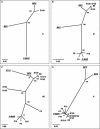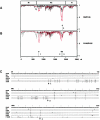Phylogenetic and evolutionary relationships among torovirus field variants: evidence for multiple intertypic recombination events
- PMID: 12915570
- PMCID: PMC187415
- DOI: 10.1128/jvi.77.17.9567-9577.2003
Phylogenetic and evolutionary relationships among torovirus field variants: evidence for multiple intertypic recombination events
Abstract
Toroviruses (family Coronaviridae, order Nidovirales) are enveloped, positive-stranded RNA viruses that have been implicated in enteric disease in cattle and possibly in humans. Despite their potential veterinary and clinical relevance, little is known about torovirus epidemiology and molecular genetics. Here, we present the first study into the diversity among toroviruses currently present in European swine and cattle herds. Comparative sequence analysis was performed focusing on the genes for the structural proteins S, M, HE, and N, with fecal specimens serving as sources of viral RNA. Sequence data published for animal and human torovirus variants were included. Four genotypes, displaying 30 to 40% divergence, were readily distinguished, exemplified by bovine torovirus (BToV) Breda, porcine torovirus (PToV) Markelo, equine torovirus Berne, and the putative human torovirus. The ungulate toroviruses apparently display host species preference. In phylogenetic analyses, all PToV variants clustered, while the recent European BToVs mostly resembled the New World BToV variant Breda, identified 19 years ago. However, we found ample evidence for recurring intertypic recombination. All newly characterized BToV variants seem to have arisen from a genetic exchange, during which the 3' end of the HE gene, the N gene, and the 3' nontranslated region of a Breda virus-like parent had been swapped for those of PToV. Moreover, some PToV and BToV variants carried chimeric HE genes, which apparently resulted from recombination events involving hitherto unknown toroviruses. From these observations, the existence of two additional torovirus genotypes can be inferred. Toroviruses may be even more promiscuous than their closest relatives, the coronaviruses and arteriviruses.
Figures






Similar articles
-
Whole genome analysis of Japanese bovine toroviruses reveals natural recombination between porcine and bovine toroviruses.Infect Genet Evol. 2016 Mar;38:90-95. doi: 10.1016/j.meegid.2015.12.013. Epub 2015 Dec 18. Infect Genet Evol. 2016. PMID: 26708248 Free PMC article.
-
Epidemiological analysis of bovine torovirus in Japan.Virus Res. 2007 Jun;126(1-2):32-7. doi: 10.1016/j.virusres.2007.01.013. Epub 2007 Feb 21. Virus Res. 2007. PMID: 17320234 Free PMC article.
-
Molecular epidemiology of Porcine torovirus (PToV) in Sichuan Province, China: 2011-2013.Virol J. 2014 Jun 5;11:106. doi: 10.1186/1743-422X-11-106. Virol J. 2014. PMID: 24903213 Free PMC article.
-
[A review of porcine torovirus research: etiology and epidemiology].Bing Du Xue Bao. 2013 Nov;29(6):667-72. Bing Du Xue Bao. 2013. PMID: 24520775 Review. Chinese.
-
Bovine torovirus (Breda virus) revisited.Anim Health Res Rev. 2004 Dec;5(2):157-71. doi: 10.1079/ahr200498. Anim Health Res Rev. 2004. PMID: 15984322 Review.
Cited by
-
Infectious salmon anemia virus specifically binds to and hydrolyzes 4-O-acetylated sialic acids.J Virol. 2004 Mar;78(6):3055-62. doi: 10.1128/jvi.78.6.3055-3062.2004. J Virol. 2004. PMID: 14990724 Free PMC article.
-
Structural basis for ligand and substrate recognition by torovirus hemagglutinin esterases.Proc Natl Acad Sci U S A. 2009 Sep 15;106(37):15897-902. doi: 10.1073/pnas.0904266106. Epub 2009 Aug 31. Proc Natl Acad Sci U S A. 2009. PMID: 19721004 Free PMC article.
-
Genetic and antigenic characterization of newly isolated bovine toroviruses from Japanese cattle.J Clin Microbiol. 2010 May;48(5):1795-800. doi: 10.1128/JCM.02339-09. Epub 2010 Mar 10. J Clin Microbiol. 2010. PMID: 20220164 Free PMC article.
-
Molecular characterization of a new PToV strain. Evolutionary implications.Virus Res. 2009 Jul;143(1):33-43. doi: 10.1016/j.virusres.2009.02.019. Epub 2009 Mar 20. Virus Res. 2009. PMID: 19463719 Free PMC article.
-
Structure, function and evolution of the hemagglutinin-esterase proteins of corona- and toroviruses.Glycoconj J. 2006 Feb;23(1-2):59-72. doi: 10.1007/s10719-006-5438-8. Glycoconj J. 2006. PMID: 16575523 Free PMC article. Review.
References
MeSH terms
Substances
LinkOut - more resources
Full Text Sources
Other Literature Sources

